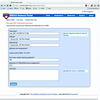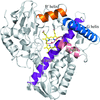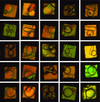issue contents
March 2012 issue

Cover illustration: Selected snapshots of the effect of beads on the intrinsic orientation of crystals on a chip (p. 321), illustrating the importance of matching bead size with crystal size for maximal effectiveness in orientating the crystals.
research papers
The crystal structure of the cytoplasmic domain of Y. pestis YscD is presented at 2.04 Å resolution.
PDB reference: cytoplasmic domain of YscD, 4a0e
The N-terminal domain of the adhesin Epa1p from C. glabrata is a C-type lectin with a β-sandwich topology.
PDB reference: Epa1-Np, 4a3x
Crystal structures of S-adenosyl-L-homocysteine hydrolase from L. luteus in complex with adenosine, cordycepin and adenine are presented.
The crystal structure of the DNA photoproduct dTT(6–4)TT in complex with an antibody Fab indicates that the central dT(6–4)T segment is fully accommodated in the concave pocket and its flanking 5′-side thymidylate and 3′-side phosphate groups are responsible for the increased antibody-binding affinity of longer photoproducts.
PDB reference: dTT(6–4)TT–64M-2 Fab fragment complex, 1keg
Adenosine phosphorylase from B. cereus shows a strong preference for adenosine over other 6-oxopurine nucleosides. Mutation of Asp204 to asparagine reduces the efficiency of adenosine cleavage but does not affect inosine cleavage, effectively reversing the substrate specificity. The structures of D204N complexes explain these observations.
PDB references: AdoP–SO4, 3uav; AdoP–Ado–SO4, 3uaw; AdoP–Ino–SO4, 3uax; D204N–Ado–SO4, 3uay; D204N–Ino–SO4, 3uaz
The structure of 5′-deoxy-5′-methylthioadenosine phosphorylase II was incorrectly reported in space group P1 with pseudo-R32 symmetry. Post-analysis showed that the correct space group is C2, a maximal non-isomorphic subgroup of space group R32.
High-resolution structures of catechol-O-methyltransferase with ribose-modified inhibitors and Mg2+ identify the side chain of Glu90 as crucial for hydrogen bonding to the ribose hydroxyl groups. Glu90 subtly aligns with the 2′-hydroxyl, but not the 3′-hydroxyl, group to increase binding affinity, explaining the observed activities of bisubstrate inhibitors with a 3′-desoxyribose moiety.
Open  access
access
 access
accessThe deformable elastic network (DEN) method for reciprocal-space crystallographic refinement improves crystal structures, especially at resolutions lower than 3.5 Å. The DEN web service presented here intends to provide structural biologists with access to resources for running computationally intensive DEN refinements.
The use of the common cryoprotectants glycerol and MPD in the structure determination of the human ABO(H) blood group glycosyltransferases GTA, GTB and their chimera causes changes in the structure that could mistakenly be attributed to single point mutations.
The crystal structure and substrate-binding and activity studies of CYP108D1, an aromatic hydrocarbon-binding cytochrome P450 monooxygenase from N. aromaticivorans DSM12444, are presented.
PDB reference: CYP108D1, 3tkt
The crystal structures of two X1 modules from the multimodular CbhA protein have been solved and it has been proposed that a possible biological function of these domains is to enhance the stability of the complex at higher temperatures.
Open  access
access
 access
accessStructures of 3-isopropylmalate dehydrogenase were determined at pressures ranging from 0.1 to 650 MPa. Comparison of these structures gives a detailed picture of the swelling of a cavity at the dimer interface and the generation of a new cleft on the molecular surface, which are accompanied by water penetration.
PDB references: SoIPMDH–IPM, 0.1 MPa, 3vkz; 160 MPa, 3vl2; 340 MPa, 3vl3; 410 MPa, 3vl4; 580 MPa, 3vl6; 650 MPa, 3vl7
By determining the structure of the catalytic domain of the C. thermocellum cellulase CelT, the mechanism of function of the enzyme in the absence of an accessory module and the structural elements that might be responsible for its stability have been proposed.
PDB reference: CelTΔdoc, 2yik
short communications
This article describes a new platform for self-assembly of large array of protein crystals on a surface for the purpose of high-throughput room-temperature X-ray diffraction studies.


 journal menu
journal menu






























